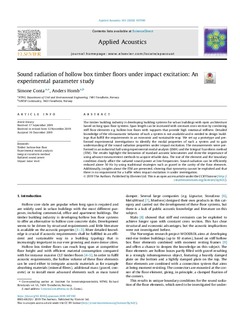| dc.contributor.author | Conta, Simone | |
| dc.contributor.author | Homb, Anders | |
| dc.date.accessioned | 2020-01-08T11:51:17Z | |
| dc.date.available | 2020-01-08T11:51:17Z | |
| dc.date.created | 2019-12-29T18:20:11Z | |
| dc.date.issued | 2019 | |
| dc.identifier.issn | 0003-682X | |
| dc.identifier.uri | http://hdl.handle.net/11250/2635316 | |
| dc.description.abstract | The timber building industry is developing building systems for urban buildings with open architecture based on long span floor systems. Span length can be increased with constant cross section by combining stiff floor elements e.g. hollow-box floors with supports that provide high rotational stiffness. Detailed knowledge of the vibroacoustic behavior of such a system is not available and is needed to design buildings that fulfill the requirements in an economic and sustainable way. We set up a prototype and performed experimental investigations to identify the modal properties of such a system and to gain understanding of the sound radiation properties under impact excitation. The measurements were performed in an industrial hall using experimental modal analysis (EMA) and the Integral Transform method (ITM). The results highlight the limitation of standard acoustic laboratories and show the importance of using advance measurement methods to acquire reliable data. The size of the element and the boundary condition clearly affect the radiated sound power at low frequencies. Sound radiation can be efficiently reduced above 50 Hz by using traditional strategies such as gravel in the cavity of the floor elements. Additionally, insights about the ITM are presented, showing that symmetry cannot be exploited and that there is no requirement for a baffle when impact excitation is under investigation. | nb_NO |
| dc.language.iso | eng | nb_NO |
| dc.publisher | Elsevier | nb_NO |
| dc.rights | Navngivelse 4.0 Internasjonal | * |
| dc.rights.uri | http://creativecommons.org/licenses/by/4.0/deed.no | * |
| dc.title | Sound radiation of hollow box timber floors under impact excitation: An experimental parameter study | nb_NO |
| dc.type | Journal article | nb_NO |
| dc.type | Peer reviewed | nb_NO |
| dc.description.version | publishedVersion | nb_NO |
| dc.source.volume | 161 | nb_NO |
| dc.source.journal | Applied Acoustics | nb_NO |
| dc.identifier.doi | 10.1016/j.apacoust.2019.107190 | |
| dc.identifier.cristin | 1764244 | |
| dc.relation.project | Norges forskningsråd: 254699 | nb_NO |
| dc.description.localcode | (C) 2019 The Authors. Published by Elsevier Ltd. This is an open access article under the CC BY license (http:// creativecommons.org/licenses/by/4.0/). | nb_NO |
| cristin.unitcode | 194,64,91,0 | |
| cristin.unitname | Institutt for bygg- og miljøteknikk | |
| cristin.ispublished | true | |
| cristin.fulltext | original | |
| cristin.qualitycode | 1 | |

